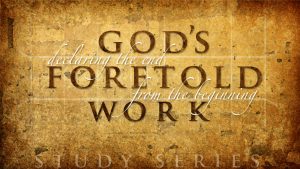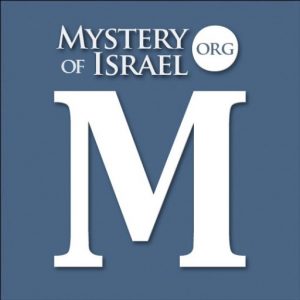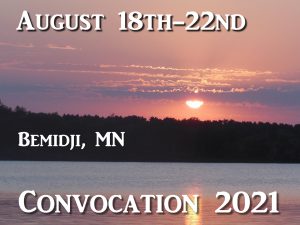Do you think Ezekiel 35 is future as well as past?
When we come to many of these kinds of prophecies, we are met with a phenomenon that is unique to Hebrew prophecy. It is the curious blending of a near fulfillment with a distant fulfillment that is much more exhaustive and that coincides with the time of Israel’s ultimate restoration at the eschatological day of the Lord. I believe that is what we have here, though most academic scholars would not warm to the idea with its implications for an abiding divine claim on the Land and its Jewish ‘occupiers’. However, such well meaning political neutrality that disregards an ancient covenant is NOT the perspective that we meet with in the prophets.
Because you have said, “These two nations and countries will be ours and we will take possession of them,” even though I the Lord was there, (Eze 35:10)
Now also many nations have gathered against you, Who say, “Let her be defiled, And let our eye look upon Zion.” But they do not know the thoughts of the Lord, Nor do they understand His counsel; For He will gather them like sheaves to the threshing floor. (Mic 4:11-12)
Such prophecies have their most complete and exhaustive fulfillment at the end of this age. That is why I believe that whatever contemporary fulfillment that parts of Eze 35 may have had in the past, it was at best only partial. There is a manifest repetition of pattern that remains constant, though details may differ in some particulars. We might call it ‘pattern eschatology’, since in both its near and far fulfillment, it remains true to the pattern that is based on covenant election and judgment.
The full and exhaustive fulfillment is necessarily future for the following reasons: There are two very clear time markers: Verse 5, “in the time their iniquity had an end,” and verse 14, “when the whole earth rejoices …” (i.e., the millennium after the day of the Lord).
You will notice that many of the verses of chapters 35 and 36 are very nearly reproduced in unmistakably similar terms in Obadiah, which clearly reaches to the day of the Lord and Israel’s final restoration. Moreover, the prophecy of Eze 35 continues on through ch 36 which is the promise of the new heart that secures Israel’s millennial permanence and abiding security in the Land.
Edom has indeed become a desolation, but this is not the full and final reach of the prophecy. Just as the everlasting hatred (Eze 35:5) persist to the end, so must this prophecy have further fulfillment in a yet greater and more final desolation in the future (Isa 34:5-17), first for Israel and then for the surrounding nations that harbor the ancient hatred for Israel in bold disregard and defiance of the everlasting covenant (Gen 17:7-8; Ps 105:10-11).
As in all the prophets, so here, Israel’s salvation and final judgement upon those who seek her destruction follows immediately after an unparalleled tribulation that has laid the whole Land desolate (Eze 35:12, 15). Hence, we must carefully distinguish between “the desolations of many generations” (Isa 61:4) during Israel’s long absence from the Land, and another very brief period desolation, dispersion, and captivity that is shown to follow closely upon a pre-tribulation return to the Land (cf. Jer 30:3-7; Eze 38:8; Zeph 2:1-2; Zech 14:2; Dan 12:1; Mt 24:21; Rev 12:6, 13-14). This return is not to be confused with the final and complete return that is shown to follow the day of the Lord.
It is interesting that Isaiah shows that the final desolation comes very shortly after the returning exiles recover possession of their temple when it is once again ‘trodden down’ an invader. “The people of thy holiness have possessed it but a little while: our adversaries have trodden down thy sanctuary” (Isa 63:18; 64:10-11; Rev 11:2). This sets the stage for the unequaled tribulation that follows immediately upon the Antichrist’s desecration of the temple, presupposing the presence of the temple, as shown by Daniel and Jesus (Dan 11:31; 12:11; Mt 24:15-16, 21; 2Thes 2:4; Rev 11:2).
There is a great paradox concerning the relation of two distinct restorations of the Land in the latter days. The great second exodus of Isa 11:11 must be seen as necessarily twofold. Time does not permit fuller development, but notice that after ‘the desolations of many generations’ (Isa 61:4), the Land is destined to become as Eden. We see this in Eze 36:35. For this cause, many naturally think that Eze 36:35 refers to the present transformation of the Land. It would ‘appear’ so, but Joel 2:3 forbids this presumption.
Taken together, these verses reconcile a tremendous paradox. There are two restorations of the Land to Edenic beauty, one before the tribulation and the other after. Eze 36:35 is millennial as its setting is the goal of the covenant in Israel’s everlasting peace and security in the Land. Not so Joel 2:3. Its setting is definitely pre-tribulational. It is BEFORE the desolation that comes with the final tribulation that climaxes in the day of the Lord. We can see how nearly the language of Joel 2:2 parallels Jer 30:7 and Dan 12:1, clear references to the unequaled tribulation that ends in Israel’s final deliverance with the Lord’s return.
Listen to Joel 2:3: “A fire devours before them; and behind them a flame burns: the land is as the garden of Eden before them, and behind them a desolate wilderness; yea, and nothing shall escape them.” This is the devastation that comes to the Land by the forces of Antichrist. Yet, in Eze 36:35, the Land has returned again to an Edenic glory, but this is AFTER the national cleansing and AFTER the new heart that secures permanent peace in the Land. .
In other words, as surely as Joel 2:3 speaks of the Edenic state of the Land BEFORE the tribulation, Eze 36:35 speaks of its millennial beauty AFTER the tribulation. You can see the paradox this tends to create. It becomes a kind of ‘optical illusion’ that tends to lead many to conclude that Eze 36:35 has already been fulfilled.
This curious juxtaposition of the two contrasting uses of the analogy of the Land to Eden, both before and after the day of the Lord is very revealing as it so well exemplifies the paradox of the modern return. Here Jews from every land have returned to establish a Jewish homeland and the Land has indeed become like Eden, just as the prophecy of Joel 2:3 requires, but the present transformation is not permanent. Tragically, the ancient enmity still persists; the discipline of the covenant still threatens, and the Land is appointed to another time of desolation by the over flooding forces led by the Antichrist.
The twofold nature of the modern return has occasioned a dangerous optimism that tends to confuse the present return with the far greater number of references that speak of a yet future return that follows the day of Israel’s national regeneration at the post-tribulational day of the Lord, the time of Jesus’ return (Mt 24:29-31; 2Thes 2:1-2, 8).
There is a paradox that can only be accounted for by recognizing two distinct stages in Israel’s return to the Land. Prophecy is fulfilled in the modern wonder of a Land that has been transformed into an Eden after ‘the desolations of many generations’ (Isa 61:4). Yet, there is another desolation of very brief duration that must supervene between the Eden that exist BEFORE the tribulation and the Edenic glory of the Land that will endure for a thousand years.
It is the paradox of the two stage return of the Jews to the Land. First there is the necessary return that is BEFORE the tribulation and therefore before the nation has come to faith (Jer 30:7; Eze 38:8; Dan 12:1; Zech 12:2-3; 14:2; Zeph 2:1-2). The second stage of return that follows the great tribulation is both final and complete. The short time of tribulation and desolation of the Land will also bring a final ‘scattering’ and ‘captivity’ for its Jewish inhabitants (Jer 30:7; Dan 9:27; 12:1, 11; Joel 3:2; Zech 14:2; Mt 24:16; Rev 12:6, 14). If context be closely considered, the far greater number of the prophecies of return, with only few exceptions, apply to the time when Israel’s enemies are brought low in to final judgment. Of course, this is the Lord’s return to destroy the Antichrist and deliver the penitent remnant of His people, Israel.
Failure to make this distinction between the long and the short is the source of much confusion and hasty conclusions that rob God’s people of critical anticipation and preparation for the degree of desolation and “distress in the Land” that many prophecies depict as underway when the Lord returns to bring the final end to the divinely ordained, ‘controversy of Zion’.
There is one more point in particular that should not be missed. As pointed out from Joel 2:3, the Land that will be made desolate by the invading forces of Antichrist is compared to Eden. In notable contrast to the use of the same term in Eze 36:35, this is very significantly BEFORE the day of the Lord. This means that the Antichrist comes down on a Land that is to be compared to Eden for its beauty.
Interpreters have usually understood such terms as ‘the pleasant Land’ (Dan 8:9) and the ‘beauteous’ or ‘glorious’ Land’ (Dan 11:16, 41) to be nothing more than a title of honor, harking back to Israel’s past (Ps 106:24; Jer 3:19; Zech 7:14). However, in view of Joel 2:3, we see that the land that will be devastated by the Antichrist is a land in full bloom. This is significant for how we see the modern return.
The magnificent prosperity of the Land, and even a tenuous peace with their enemies, with the momentary recovery of their holy places (Isa 63:18; 64:10-11) is no ground for security. It will be the responsibility of the maskilim (Dan 11:32, 33, 35; 12:3, 10) to warn those who prematurely celebrate the return of temple and sacrifice and the deceitful peace that makes it possible (Isa 28:15, 18; Dan 8:25; 9:27; 11:23; 1Thes 5:3). Such a presumption of peace before a final tribulation is a false and dangerous dream that must ignore the very clearest of scriptures from the Hebrew canon (particularly Jer 30:7 with Dan 12:1-2, 11).
Now here’s what’s of special interest to me: In Dan 11:41, a passage that most interpreters agree is AFTER the invasion of the Antichrist (compare Dan 11:36-37 with 2Thes 2:4), Edom, Moab, and Ammon, the territories that make up modern Trans-Jordan, are said to “escape out of his (i.e., the Antichrist’s) hand …”. What does this mean? I think it means two things that should be well underlined, one that is probable and one that is most certain.
Firstly, when we look at Jordan’s current animus against any right of Jewish access to the temple mount, I can well imagine that Jordan will escape invasion by the Antichrist, not only because they pose no military resistance, but according to the scriptures we have just reviewed (and there are many others that imply the same), the people who still harbor “the everlasting hatred” (Eze 35:5) are in full sympathy with what is happening to the Jewish people in the devastation that has swept their Land under Antichrist. This brings me to the second reason that God gives special mention of this territory in Dan 11:41.
I can’t go into all the argument as manuscripts and translation decisions are argued and compared, but suffice it to say that the best evidence, from what I consider the best textual sources and preferred translations, shows clearly that Isa 16:4 should NOT be translated to mean that God is commanding Israel to hide the dislocated daughters of Moab, but quite the opposite. He is commanding the daughters of Moab to hide “His outcasts,” in this case, Jews that are in flight from the face of the Antichrist (‘the extortioner who treads down’). The Septuagint and Masoretic text, among others, confirm this reading.
In keeping with a few lesser known translations, here is how the more popular NKJV translates the passage in its entirety.
1 Send the lamb to the ruler of the land, From Sela to the wilderness, To the mount of the daughter of Zion.
2 For it shall be as a wandering bird thrown out of the nest; So shall be the daughters of Moab at the fords of the Arnon.
3 “Take counsel, execute judgment; Make your shadow like the night in the middle of the day; Hide the outcasts, Do not betray him who escapes.
4 Let My outcasts dwell with you, O Moab; Be a shelter to them from the face of the spoiler. For the extortioner is at an end, Devastation ceases, The oppressors are consumed out of the land.
5 In mercy the throne will be established; And One will sit on it in truth, in the tabernacle of David, Judging and seeking justice and hastening righteousness.” (Isa 16:1-5).
Note that the time could hardly be clearer from the context. It is just before the Messiah sits on the throne in the re-established ‘tabernacle of David” (Isa 16:5). Therefore, this cannot be God commanding Israel to offer refuge and hiding to the dislocated daughters of Moab. Rather, it is God commanding the daughters of Moab to provide shelter to Jews in flight from the Antichrist.
Due to their own sudden displacement through the threat of persecution from their antichrist countrymen, these believing ‘daughters of Moab’ will be at the ‘fords of the Arnon’ (this sounds like the canyon gorge where the Arnon river spills into the dead sea). I believe we have here strong evidence that the displaced daughters of Moab are being divinely charged to permit the outcasts of Israel (“My outcasts”) to dwell with them in the Antichrist time of mutual flight from persecution.
But even beyond the close questions of how this contested text should be translated, there is sound theological reason to reject the majority of translations. Think about it: Would God be commanding Israel, who will be inundated by Antichrist armies at this time, to receive hide wanderers from the one nation that is promised exemption from Antichrist destruction? (Dan 11:41). Or should we expect just the opposite?
To suppose the former would be opposed to a number of scriptures that show the flight of Jews down into the region of Petra in southern Jordan. As this text implies, they will be making their way there through this particular region of Jordan in their desperate flight to the place prepared of God in the ‘wilderness’ (Rev 12:6, 14). This is evident from the several passages that show that one stronghold of Jewish flight and hiding in the wilderness will be the region of Petra in particular. Isa 42:11 shows that the shouts of redemption will go up from “the inhabitants of the rock” (translated ‘rock’ only here. In the only other two instances, it is translated, Petra or Selah; 2Kings 14:7; Isa 16:1), from the ‘wilderness’ of Kedar. This is also the area of the Horites, the people of the caves (‘chambers’; Isa 26:20; Mt 24:26).
We note that a number of passages depict Israel’s last experience under Antichrist as resulting in a return to the wilderness, from whence they return in a kind of ‘second exodus’ after the Antichrist is destroyed by the Lord’s return (Isa 35; 40:3; 42:11; 43:19-20; 64:10-11; Jer 31:2; Eze 29:35-36; Hos 2:14; Mt 24:16, 26; Rev 12:6, 14). In all of these references and many more, the context is the last and unequaled tribulation that precedes Israel’s everlasting deliverance.
Such texts that show another exodus, not only in return from the exile of ‘many generations’ (Isa 61:4), but a yet further, post-tribulational return from a final experience of wilderness flight and hiding. You can see how these texts formed the background for Revelation’s depiction of the flight of the woman into the wilderness (Rev 12:6, 14). Again, this becomes clear only if we make the necessary distinction between the desolations of the long exile and the desolation of the short tribulation at the end.
For example, by comparing such passages as Zech 14:2; Dan 12:1; Mt 24:21; Rev 12:6, 14 with a return passage such as Isa 27:12-13, we can see that when the great Jubilee trumpet of final deliverance sounds (compare Isa 27:13 with Mt 24:31), a remnant, described here as “ready to perish,” begins their return home from the lands of Assyria and Egypt. Of course, the post-tribulational return of the Jews will be from all lands, but here, Assyria and Egypt are specially mentioned. This is significant, because in very recent history, these particular territories have become so terrifically hostile as to reduce their once flourishing Jewish populations to almost nothing. This raises the question, “how did this remnant of Jews get there?” Could the answer be that prospects for Jewish survival will be more hopeful in such hostile territories than to remain inside the Land? That seems to be where the evidence points.
In a context that is undeniably future, Micah 4:6-10 shows that the final redemption comes to a remnant that is “dwelling in the field” that was once Babylon. This is also ancient Assyria, the modern nation of Iraq. Today, this territory is an uninhabited, unsettled area that for generations was a place for the Arabian to ‘pitch his tent’, exactly as predicted in Isa 13:19-22. Can it be that the Arabian will not be the only one pitching his tent in that desolate wilderness during the coming tribulation?
What is of special interest is why the daughters of Moab (the kind of persons that would be inclined to obey the command to hide and render aid to Jews in flight), would find themselves also ‘cast out of the nest, as a wandering bird’? I believe the answer is that Jordanian believers will be under persecution from their fellow countrymen that sympathize with the persecuting policies of Antichrist against the Jews. For this cause, they too will find themselves in need of hiding places.
A sign of their love of the truth will be their willingness, and sense of privilege to prepare for the coming of Jews in flight. This suggests to me that with all believers wherever Jacob is found, Jordanian believers in particular are specially situated and specially called to anticipate and prepare to be a covering and shelter for Jacob in the time of his calamity.
It also occurs to me that this might be the key to the somewhat cryptic command in Isa 16:1 to send the tribute lamb from Selah / Petra to the ruler of the Land, that is to the King Messiah who is about to take His throne on mount Zion (Isa 16:1, 5). Indeed, for Jordanians to hide ‘His outcasts’ in such a dangerous area in the time of Israel’s frantic flight from the Antichrist, is a peace offering of sweet smell, since it could only be done with utmost danger of utmost cost.
Reggie





